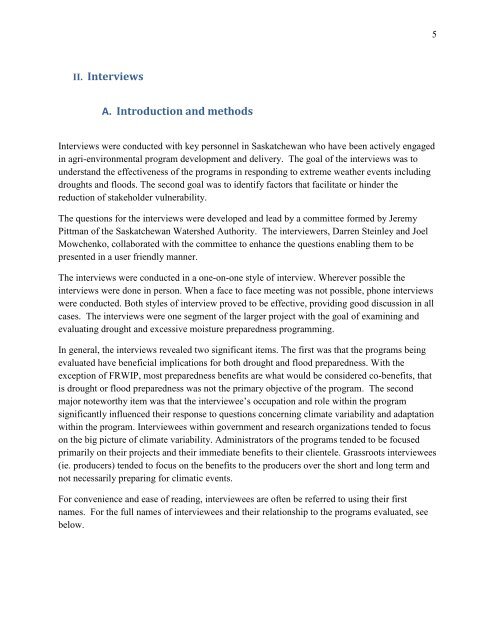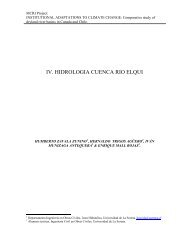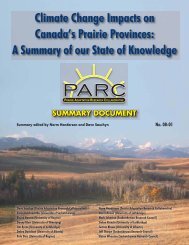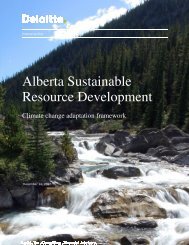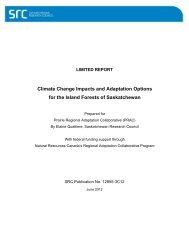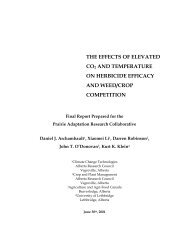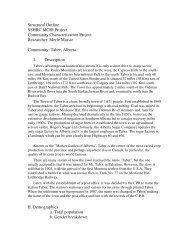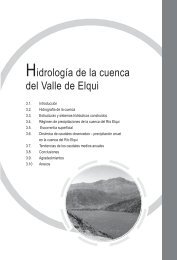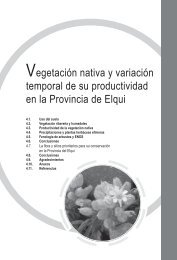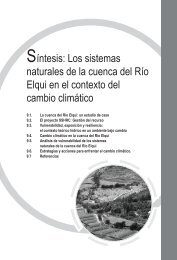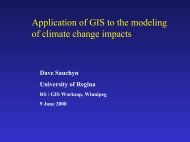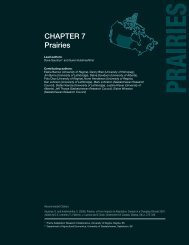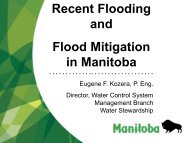Evaluation of Drought and Excessive Moisture Preparedness ...
Evaluation of Drought and Excessive Moisture Preparedness ...
Evaluation of Drought and Excessive Moisture Preparedness ...
You also want an ePaper? Increase the reach of your titles
YUMPU automatically turns print PDFs into web optimized ePapers that Google loves.
5<br />
II. Interviews<br />
A. Introduction <strong>and</strong> methods<br />
Interviews were conducted with key personnel in Saskatchewan who have been actively engaged<br />
in agri-environmental program development <strong>and</strong> delivery. The goal <strong>of</strong> the interviews was to<br />
underst<strong>and</strong> the effectiveness <strong>of</strong> the programs in responding to extreme weather events including<br />
droughts <strong>and</strong> floods. The second goal was to identify factors that facilitate or hinder the<br />
reduction <strong>of</strong> stakeholder vulnerability.<br />
The questions for the interviews were developed <strong>and</strong> lead by a committee formed by Jeremy<br />
Pittman <strong>of</strong> the Saskatchewan Watershed Authority. The interviewers, Darren Steinley <strong>and</strong> Joel<br />
Mowchenko, collaborated with the committee to enhance the questions enabling them to be<br />
presented in a user friendly manner.<br />
The interviews were conducted in a one-on-one style <strong>of</strong> interview. Wherever possible the<br />
interviews were done in person. When a face to face meeting was not possible, phone interviews<br />
were conducted. Both styles <strong>of</strong> interview proved to be effective, providing good discussion in all<br />
cases. The interviews were one segment <strong>of</strong> the larger project with the goal <strong>of</strong> examining <strong>and</strong><br />
evaluating drought <strong>and</strong> excessive moisture preparedness programming.<br />
In general, the interviews revealed two significant items. The first was that the programs being<br />
evaluated have beneficial implications for both drought <strong>and</strong> flood preparedness. With the<br />
exception <strong>of</strong> FRWIP, most preparedness benefits are what would be considered co-benefits, that<br />
is drought or flood preparedness was not the primary objective <strong>of</strong> the program. The second<br />
major noteworthy item was that the interviewee’s occupation <strong>and</strong> role within the program<br />
significantly influenced their response to questions concerning climate variability <strong>and</strong> adaptation<br />
within the program. Interviewees within government <strong>and</strong> research organizations tended to focus<br />
on the big picture <strong>of</strong> climate variability. Administrators <strong>of</strong> the programs tended to be focused<br />
primarily on their projects <strong>and</strong> their immediate benefits to their clientele. Grassroots interviewees<br />
(ie. producers) tended to focus on the benefits to the producers over the short <strong>and</strong> long term <strong>and</strong><br />
not necessarily preparing for climatic events.<br />
For convenience <strong>and</strong> ease <strong>of</strong> reading, interviewees are <strong>of</strong>ten be referred to using their first<br />
names. For the full names <strong>of</strong> interviewees <strong>and</strong> their relationship to the programs evaluated, see<br />
below.


